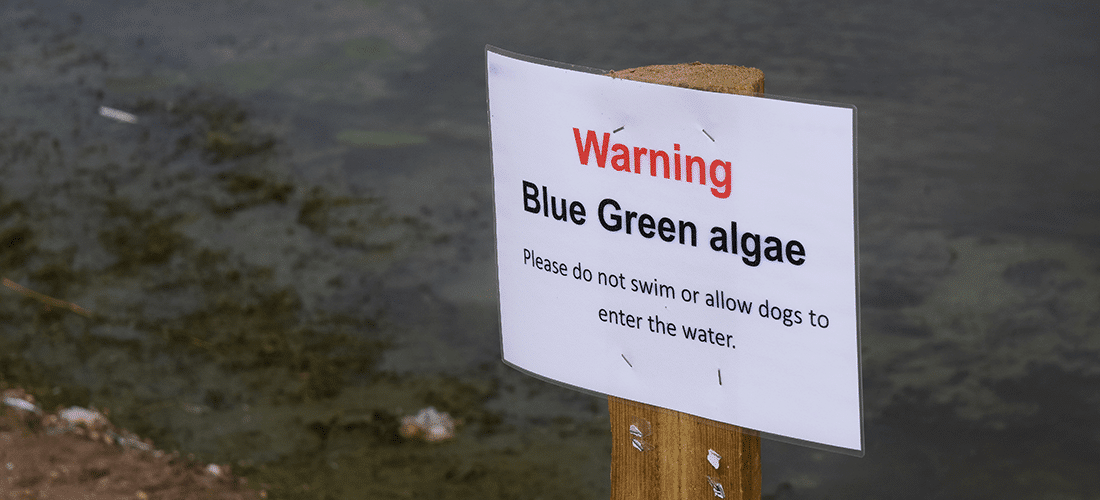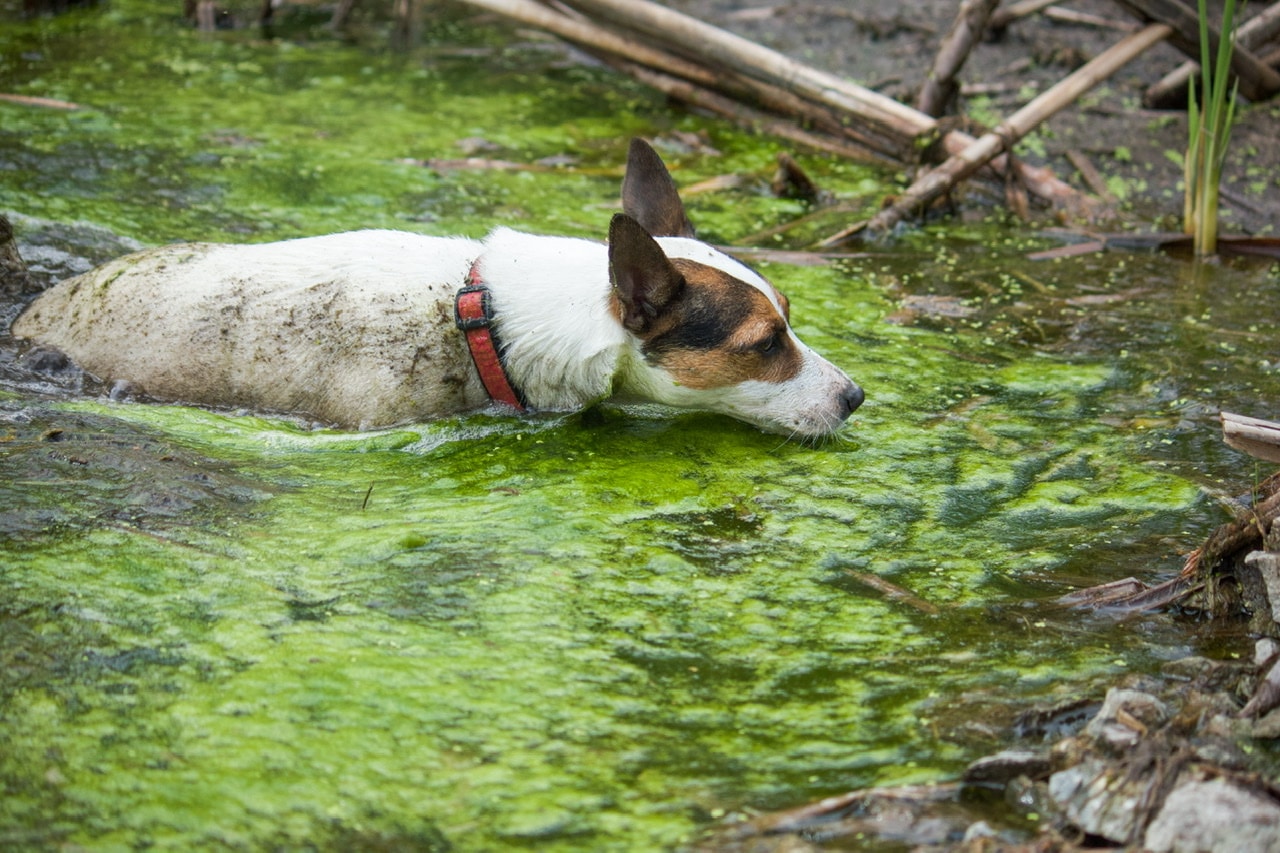-
Adopt
-
Veterinary Care
Services
Client Information
- What to Expect – Angell Boston
- Client Rights and Responsibilities
- Payments / Financial Assistance
- Pharmacy
- Client Policies
- Our Doctors
- Grief Support / Counseling
- Directions and Parking
- Helpful “How-to” Pet Care
Online Payments
Emergency: Boston
Emergency: Waltham
Poison Control Hotline
-
Programs & Resources
- Careers
-
Donate Now
 There’s nothing like spending a sunny day by the water with your pet in the summer. However, a hidden danger could turn your outing into a crisis: harmful blue-green algae blooms. As temperatures rise, these blooms become more common, posing severe, potentially life-threatening risks to pets.
There’s nothing like spending a sunny day by the water with your pet in the summer. However, a hidden danger could turn your outing into a crisis: harmful blue-green algae blooms. As temperatures rise, these blooms become more common, posing severe, potentially life-threatening risks to pets.
Many pet owners are unaware of the dangers of blue-green algae toxicosis and how to identify it. To ensure your summer outings remain safe, we’ve sought the expertise of Dr. Courtney Peck, an Emergency and Critical Care veterinarian at the MSPCA-Angell in Waltham, MA. Her insights will give you the confidence to protect your pet from this potentially deadly threat.
Where is blue-green algae (cyanobacteria) found, and what does it look like?
Dr. Peck: Cyanobacteria are photosynthetic, prokaryotic organisms (they are not actually true algae) that exist in fresh, brackish, and salt waters worldwide. Toxicity occurs from swimming in or drinking from contaminated water, although toxicity secondary to licking hair coat coated with contaminated water has also been reported.
 Sometimes, cyanobacteria causes visible blooms in the water. The “blue-green” nickname is associated with the appearance of ‘pea soup,’ which is sometimes seen in the water from the bacterial bloom. However, cyanobacteria can cause various changes in the water’s color from deep green to red or pink or, in some cases, cause no visual change. Cyanobacterial blooms can occur in any amount or type of water, including oceans, rivers, water puddles, water troughs, and water buckets.
Sometimes, cyanobacteria causes visible blooms in the water. The “blue-green” nickname is associated with the appearance of ‘pea soup,’ which is sometimes seen in the water from the bacterial bloom. However, cyanobacteria can cause various changes in the water’s color from deep green to red or pink or, in some cases, cause no visual change. Cyanobacterial blooms can occur in any amount or type of water, including oceans, rivers, water puddles, water troughs, and water buckets.
Conditions that favor the proliferation of cyanobacterial blooms include warm weather, stagnant water, lack of rain, and water nitrification from an influx of phosphorus and nitrogen. Visually examining the water cannot distinguish between potentially toxic and harmless cyanobacterial blooms.
Blooms often result in pockets of high concentrations of cyanotoxins within the water, making detection difficult because these pockets can move or dissipate. Wave action from wind can push cyanobacterial blooms against shorelines, concentrating the cyanotoxins at the shoreline and putting animals that drink from those areas at risk for toxicosis. Reported cases of cyanobacterial toxicosis are increasing in both dogs and humans, with year-round risk in warm climates.
What types of animals are affected by blue-green algae?
Dr. Peck: Severe illness has been documented in people, livestock, wildlife, birds, dogs, fish, and other aquatic animals. Among domestic species, dogs are the most susceptible to cyanobacterial toxicosis. Toxicosis is rare in cats because of their lower risk of exposure.
What signs and symptoms can cyanobacteria cause?
Dr. Peck: Blue-green algae can produce toxins that affect the nervous system (neurotoxins), liver (hepatotoxins), or skin (dermatotoxins).
(hepatotoxins), or skin (dermatotoxins).
Signs of cyanobacteria poisoning in dogs may include muscle rigidity, muscle tremors, convulsions/seizures, weakness/collapse, respiratory distress, bluish/purple or gray gums or tongue (due to respiratory failure), anxiety, hypersalivation, urinary incontinence, defecation, diarrhea, vomiting, and death. If you notice any of these signs in your pet, seeking immediate veterinary care is crucial.
Clinical signs due to hepatotoxins can occur within minutes to a few hours of exposure and may include vomiting, diarrhea, weakness, pale gums/tongue, and collapse from acute hypovolemic shock. Some animals may collapse and die with no other noticeable signs. Patients who survive the peracute phase may initially vomit, appear to recover or have mild lethargy for approximately 12 hours, and then develop signs of liver failure. Findings associated with liver failure may include weakness, icterus/jaundice, depression, and evidence of bleeding (bloody diarrhea, bloody vomit).
Dogs chronically receiving blue-green algae supplements contaminated with HCs may develop a more gradual onset of anorexia, abdominal discomfort, lethargy, polyuria, and polydipsia.
Dermatological signs are more common in humans.
What is the treatment for blue-green algae poisoning?
Dr. Peck: If exposure was recent, decontamination (guided by a veterinarian—owners should not do this at home) might be helpful, depending on the patient’s signs and mentation. It’s crucial to seek immediate veterinary care in such situations, as only a professional can provide your pet with the necessary treatment and support.
Once clinical signs develop, treatment depends on the type of toxin causing the illness. Anti-seizure medications, muscle relaxants, and general stabilization are warranted for neurologic signs. For hepatic failure, general supportive care (intravenous fluids, liver protective therapy) is recommended. However, no specific treatment for liver toxicosis due to cyanobacteria has been effective, especially in cases with rapid onset of clinical signs.
What is the prognosis and recovery like for a dog who ingested blue-green algae?
Dr. Peck: The prognosis for dogs exposed to cyanobacteria neurotoxin is guarded to poor. Most neurotoxic cyanotoxin poisonings result in death regardless of treatment because of the rapid action of the toxins. A few cases of dogs recovering after being treated for mild signs have been reported.
How can I keep my dog safe from blue-green algae poisoning?
Dr. Peck: Do not allow dogs to swim, wade in, or drink water with visible cyanobacteria. Toxic blooms typically discolor fresh water in various shades of green; however, it is impossible to tell by appearance whether the water contains cyanotoxins.
whether the water contains cyanotoxins.
Algal blooms are self-limiting, dying off when nutrients have been depleted. Algaecides, chemicals used to control or kill algae, can be used to manage algal blooms. However, if toxigenic strains are present, they will release toxins as they die, and toxin levels will significantly rise. Toxins can persist in the water for up to a few weeks after cyanobacteria die, so it’s essential to be cautious even after the visible bloom has disappeared.
What should I do if my dog goes in water with blue-green algae?
Dr. Peck: Again, it is impossible to tell if water contains the toxins. If your dog goes into water that has confirmed toxins from the cyanobacteria, it should be evaluated by a veterinarian immediately. The sooner therapeutic intervention occurs, the better the chance of a positive outcome.
Are humans affected by blue-green algae?
Dr. Peck: Yes, humans can also be affected. If you think your dog has been in water containing toxic blue-green algae, you should bathe it with soap and fresh water and wash your hands.
x
Preventing your dog from blue-green algae blooms is critical. Please stay vigilant on your walks and watch him if he jumps into a body of water. Have fresh water on hand when he gets thirsty to avoid drinking from stagnant ponds or lakes. Blue-green algae can cling to your pet’s fur and be ingested when they groom themselves, so be cautious before letting your pet swim and rinse thoroughly with fresh water afterward.
If you think your pet may have ingested something harmful, contact the MSPCA-Angell Emergency and Critical Care service immediately. Happy and safe swimming this summer!
24/7 Emergency Service
MSPCA-Angell Boston
Angell Animal Medical Center
350 S. Huntington Avenue
Boston MA 02130
Phone: 617-522-7282
MSPCA-Angell West
293 Second Avenue
Waltham, MA 02451
Phone: 781-902-8400




